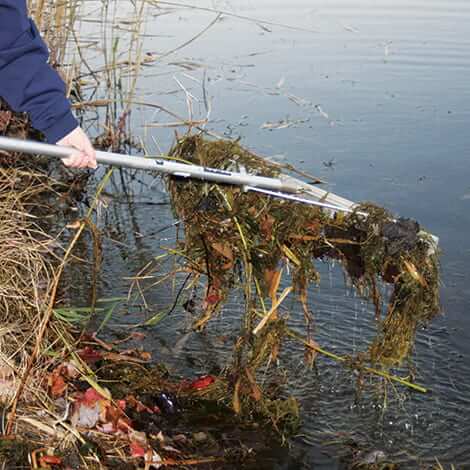Debris on the surface of a pond, like algae or fallen leaves, can sink to the bottom and start to decay, adding to the muck and detritus that is already there. All that debris degrades water quality, compromises fish, provides a nutrient source for nuisance weeds and algae, and can even affect how some products work. Dead vegetation also makes a great nesting area for muskrats, leeches, snakes, and other pests.
Many types of weeds and algae can spread by seeds or spores if the plant is shaken or if plant fragments are left floating in the water. Killing the vegetation using herbicides and algaecides before attempting to remove them will help prevent this and get you on your way to a clean pond.
Contact Chemicals
Some chemicals, like Algae Defense and Ultra PondWeed Defense, need to make contact with the vegetation in order to kill it. Raking the vegetation before treating it can break the plant into smaller pieces making it harder for the chemical to make contact. Chara and many algae reproduce by fragmentation rather than a defined root system, so if the chemical does not make contact with all the vegetation it will just keep on growing.
Systemic Chemicals
A systemic chemical, like Shoreline Defense Emergent Weed Control, works by being absorbed into the growth system of emergent shoreline weeds, like cattails, via their leaves and kills them down to the roots. Similar to contact chemicals, it is best to treat first as cutting the plants down stops the absorption process and prevents the chemical from getting into their system. For more information of which chemical is best to treat your algae or weeds, see our Weed Identification Guide.
Ready for Removal
After you have treated and killed the problem plants, then you should pull the dead debris from the pond using a weed cutter and rake. The Weed Cutter and Razer Rake are perfect tools for the job. Removing dead vegetation will prevent all that decaying matter from becoming fertilizer for future growth.
Hamper Weed and Algae Growth
Weeds and algae are, unfortunately, not fully preventable. Getting rid of areas of major vegetation will help you keep better control over the beauty of your pond. After removal, there are proactive steps you can take to slow down the impending weed and algae growth.
Decrease the amount of re-growth by using treatments of
MuckAway and Pond Dye. MuckAway beneficial bacteria will eliminate bottom-of-the-pond muck that fertilizes pond weeds and algae. MuckAway is even effective in areas of high water flow, like canals, beaches and lakefront property. When applied consistently once every two weeks when water temperatures are above 50°F and used with a bottom-diffused aeration system, MuckAway can break down up to 2 inches of pond muck per month as a spot treatment. If you want to treat areas 2 acres or larger, MuckAway Total Lake eliminates up to 2 inches of muck per month with treatments every 4 weeks. Apply MuckAway only when water temperatures are above 50°F.
Pond Dye will shade the water and prevent UV rays from accelerating weed and algae growth. No matter what color of Pond Dye you choose the amount of protection will be equal. Pond Dye comes in liquid form or in water soluble packets. Dye will need to be applied approximately every 4 - 6 weeks to be most effective. Pond Dye has no temperature restriction and can be applied any time of year.
Adding
aeration will also help reduce weed and algae re-growth. Aeration can combat muck and other decomposing debris by increasing the dissolved oxygen and circulating the water. This encourages the colonization of beneficial aerobic bacteria that consume the nutrients to reduce existing muck build-up and prevent it from accumulating in the future.
